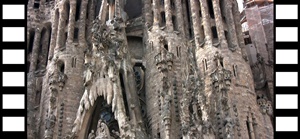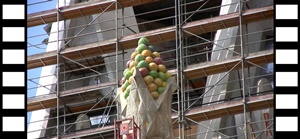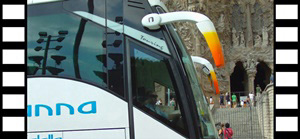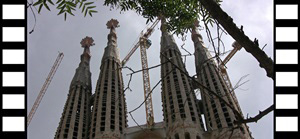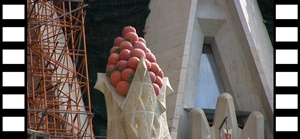Our plan for the day was to start out with a visit to the Sagrada Família, but first we walked
around a little on La Rambla near our hotel, and happened upon the Casa Bruno Cuadras,
also known as the Umbrella House. This building is the work of architect Josep Vilaseca, who
refurbished it in 1883. It was once an umbrella factory, and is covered with cast-iron umbrellas
of assorted shapes and sizes. It is also covered with Chinese and Japanese imagery, and has
balconies that look Egyptian. The ground floor of the building is a bank. And there's a dragon
sticking out from the corner. But what the building lacks in cultural consistency, it more than
makes up in its quirky attractiveness.

West Face of Umbrella House

Japanese-Style Decoration

West Face

Corner Dragon with Lantern and Umbrella
We boarded the Metro at the Liceu stop on La Rambla and traveled northeast to the Sagrada
Família.
Bob at Metro Stop
The Basílica i Temple Expiatori de la Sagrada Família (Basilica and Expiatory Church of the
Holy Family) is the masterpiece and life's work of the architect Antoni Gaudí, who worked on it from
1883 until his death in 1926. The church was originally conceived by architect Francisco del Villar
as having a neo-gothic style, as was popular at the time, but differences between Villar and the
project managers resulted in del Villar's resignation from the project in 1883. A recommendation led
to the hiring of the 31-year-old Gaudí, who had some very different ideas.
Antoni Gaudí (1878)
While Gaudí was a devout Catholic, he also was fascinated by nature and its forms and structures.
Many of these forms and structures found their ways into Gaudí's architecture, whether inspired
by trees or plants, animals or mountains. This, combined with truckloads of Christian imagery and
general Gaudí weirdness, makes for one of the most peculiar churches you're likely to see
anywhere. And one of the most amazing and monumental, all at the same time.
The Sagrada Família
Gaudí envisioned the church as having three principal façades, devoted to Christ's birth (the
Nativity façade), death (the Passion façade) and resurrection (the Glory façade). He also
envisioned it as bristling with 18 gigantic towers, 12 devoted to the apostles, four to the
evangelists (writers of the New Testament), and one each to Jesus and the Virgin Mary. The
shortest of the towers (some of the apostle towers) were to be 328 feet tall, and the tallest
(the Jesus tower) was to be 558 feet tall. With the scale and amount of detail (and financial
realities), Gaudí had no illusions as to living to see the church completed. Even so, his
life was tragically cut short in 1926, when he was run over by a streetcar at the age of 74.
After a well-attended funeral procession (with a project of this scale and ambition, Gaudí
was something of a celebrity), he was buried in the crypt of the Sagrada Família, the basic
structure of which had been largely completed at the time.
At Gaudí's death, the Nativity façade was nearing completion (it was finished in 1930), but
not much had been done on the other façades. And only one apostle tower was finished. Clearly
there was a long way to go. It didn't help any when many of Gaudí's drawings and models were
destroyed during the Spanish Civil War, along with some of the construction. But by this time
the four towers above the Nativity façade (devoted to apostles Barnabus, Simon, Judas
Thaddaeus and Matthias) had been completed.
The northeast-facing Nativity façade and its towers were the first things confronting us as
we emerged from the Metro's Sagrada Família station. The façade is an overwhelming explosion
of life, and its towers, while being among the shortest planned for the church, are
nonetheless immense. It's no wonder that this façade is the most popular, and the drop-off
point of all the tour buses.

Lower Portion, Nativity Façade

Upper Portion, Nativity Façade

Bell Towers and Cranes

Nativity Façade and Bell Towers

Nella and Nativity Façade

Side Wall Peaks with Fruit

Side Wall, Fruit and Bell Towers

Hope Portico

The Tree of Life

Pelican, Jesus Anagram and Angels

Charity Portico

Detail, Charity and Faith Porticos

Faith Portico

Faith Portico and Apse Façade
Nativity Façade and Tour Bus
We thought about going inside the church to see the interior, and we saw a line that seemed to
begin in front of the Nativity façade. We followed the line to see where it went. It went to the
corner near the façade, around the back of the church past the area of the crypt, and then
around the other side of the church, entering through a door in the Passion façade. It didn't
seem to be moving very fast. We decided it would be a good idea to return early on a later day,
to beat the crowd.
Construction of the Passion façade began in 1954, following the general plan of some surviving
drawings by Gaudí. In contrast to the lively Nativity façade, the Passion façade is stark and
barren, and was actually rather plain until 1986, when the artist Josep Maria Subirachs started
work on sculptural groups for it, depicting various scenes from the Passion of Christ. While the
figures on the Nativity façade were generally realistic depictions of humans and other creatures,
those on the Passion façade turned out to be abstract and angular (actually sort of blocky), and
as a result were quite controversial. Nevertheless, the Passion façade is considered to be
complete, except for some additional detail work planned above the sculptural groups.

Passion Façade Towers

Passion Façade and Towers

Passion Façade

Ecce Homo

Crucifixion and the Veronica

Soldiers Playing Dice and Longinus

Passion Façade and Towers

Bob and Passion Façade

Cloister and Side of Church

Towers, Cranes and Scaffolding

Fruit

Side of Church, Fruit and Entry Line
Making our way around to the Glory façade, it became quite obvious that the Sagrada Família
remains a work in progress. At the time of our visit, the basic structural elements of the
façade were still being put in place, and as yet there were no decorative elements or towers.
Nor had any other towers been raised yet, beyond the eight above the Nativity and Passion
façades. But at last there is light at the end of the tunnel – it is estimated that the church
will be completed in ten years or so. For more information on the church, including
construction updates, see
the official Sagrada Família website.
Construction of Glory Façade
Across from the in-work Glory façade was a souvenir shop that had a model of what the church is
supposed to look like when completed. While not interested in paying the large asking price for
owning the model, we were happy to take some pictures.
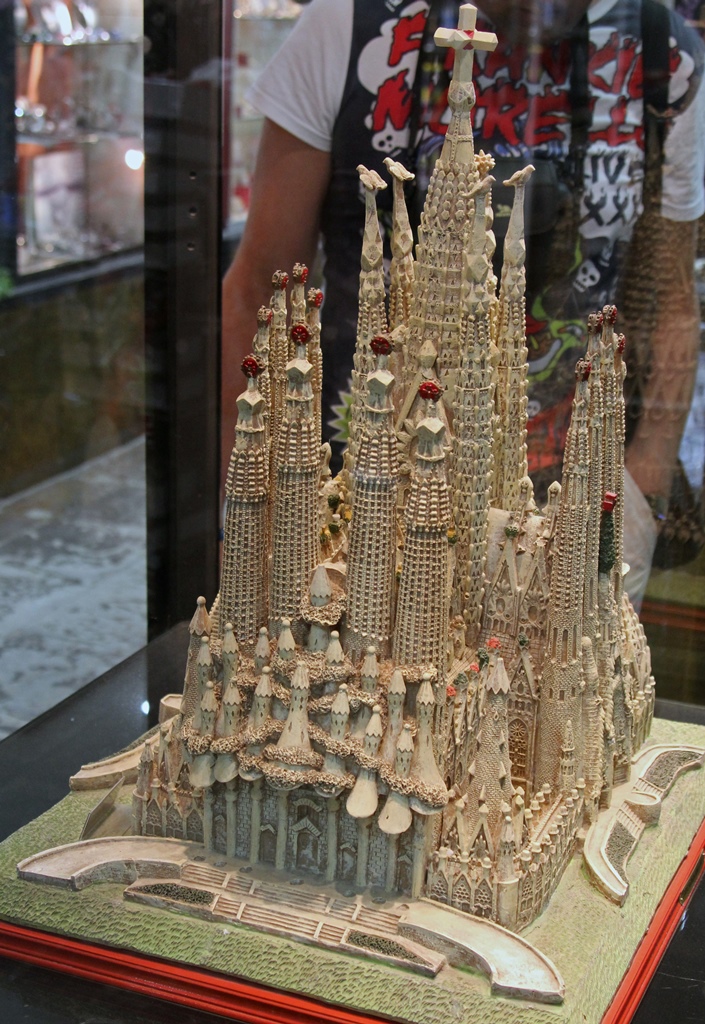
Church Model, Glory Façade

Church Model, Nativity Façade
We completed our circumnavigation of the Sagrada Família, again admiring the towers of the
Nativity façade.

Tower of Matthias, Scaffolding and Fruit

Pinnacle, Tower of Matthias
We returned to the Metro station from which we'd embarked and travelled west to visit another
Gaudí creation, a building known as La Pedrera.











